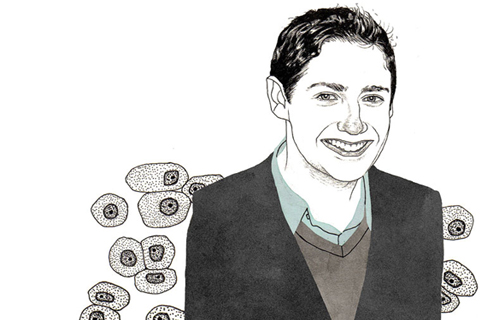In his office at U of T Mississauga, medicinal chemist Patrick Gunning is showing a visitor two images that generated a lot of excitement in his lab a few months ago. In the picture on the left is a mouse with leukemia; a tumour shows up as a small brown smudge on the animal’s white fur. The image on the right depicts the same mouse after just one week of treatment with a new compound that Gunning has designed to fight the cancer. In the second image, the tumour has vanished.
Gunning has achieved similarly promising results in mice with multiple myeloma – a rare blood cancer – and breast cancer. He’s eradicated brain cancer in human tissue samples. His findings have adorned the covers of prominent academic journals, he’s filed seven patents, and venture capital and pharmaceutical companies have come knocking. In a world where scientists can toil for decades to get a single drug approved, Gunning, 33, acknowledges that his lab has been making rapid progress on potential treatments for four types of cancer: “I honestly can’t believe how lucky we’ve gotten,” he says.
Luck may be part of it, but cancer research is highly competitive. Gunning works 14 hours a day, supervising a lab of 22 students and post-docs who help design, synthesize and evaluate potential cancer-fighting compounds, to stay ahead of the few other labs around the world pursuing the same goals. Spending long hours on challenging problems seems to be part of his DNA –or a function of his Scottish upbringing, surrounded by Type A personalities. “My sister, my grandfather, my mother – we are all workaholics,” he says.
Several years ago, while doing his post-doc at Yale University, Gunning became intrigued by a protein called “Stat3,” which promotes growth in normal cells but in cancerous cells drives tumour formation. What was interesting, says Gunning, was that even though normal cells can survive without Stat3, cancer cells can’t. He realized that if he could find a way to disrupt the production of Stat3, he should, in theory, be able to stop cancer cells from replicating.
Gunning’s success so far suggests he’s on the right track. But even the most promising compound has many hurdles to clear before it can become a bona fide cancer drug. Among the potential problems: the treatment might not work in humans, or it might be toxic at levels required to be beneficial. As a medical chemist, he can modify the compound to make it more effective, but this takes time and money. Gunning lost a grandmother and grandfather to cancer; he knows that patients and their families need better treatments as soon as possible. So he spends significant time speaking with potential donors and completing grant applications, in the hope of securing enough funding to accelerate his quest to find new drugs. “I really want to see a Stat3 drug in clinical trials,” he says. “If I’m able to do that, I think I’ll have done my job.”
Recent Posts
U of T’s 197th Birthday Quiz
Test your knowledge of all things U of T in honour of the university’s 197th anniversary on March 15!
Are Cold Plunges Good for You?
Research suggests they are, in three ways
Work Has Changed. So Have the Qualities of Good Leadership
Rapid shifts in everything from technology to employee expectations are pressuring leaders to constantly adapt







2 Responses to “ Starving Cancer Cells ”
As someone currently at the end of cancer treatment, it gives me hope to hear about this new drug, as I've always wondered why there hasn't been anything new developed besides chemo and radiation variations, and which have been around for decades. Thanks!
Very good research, with determination!